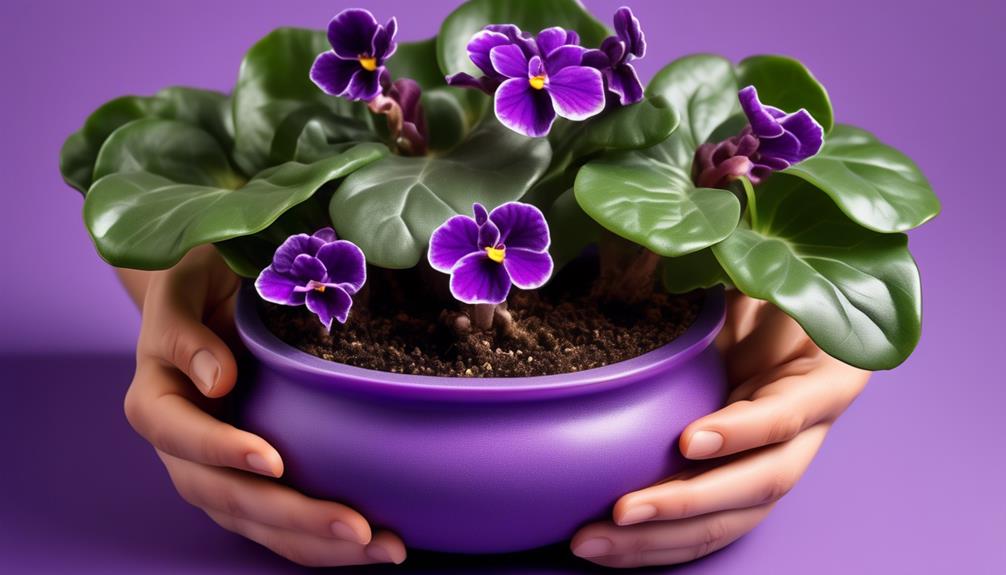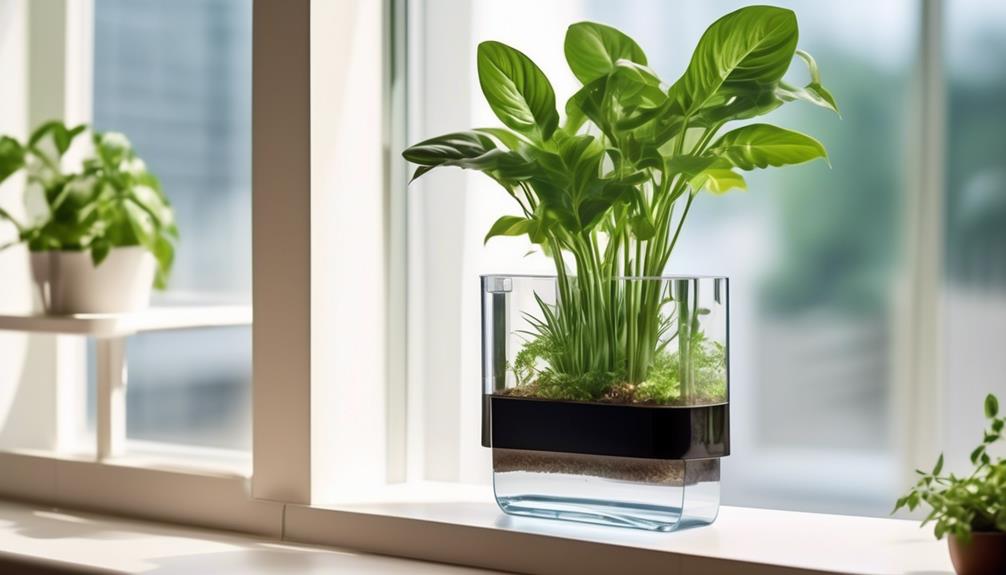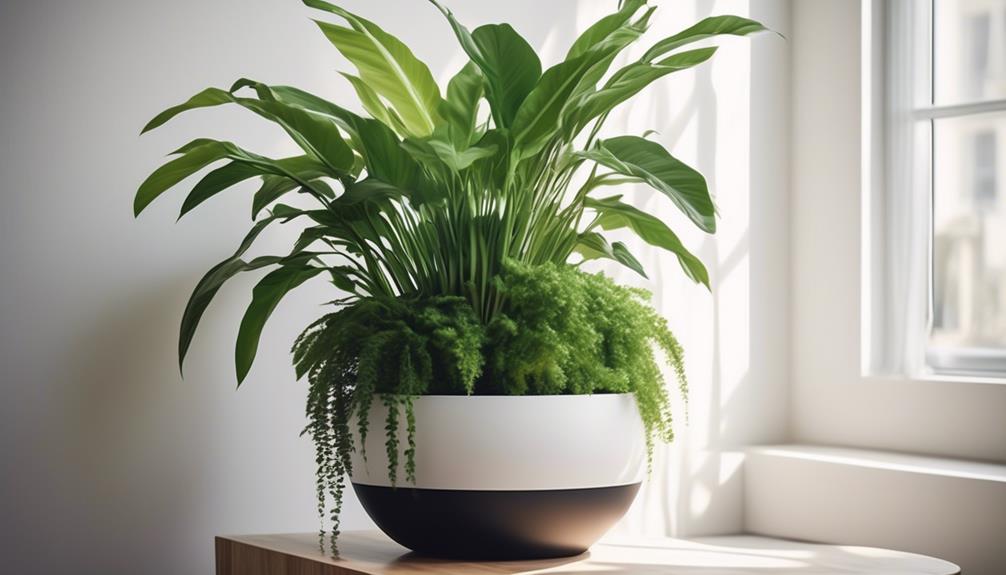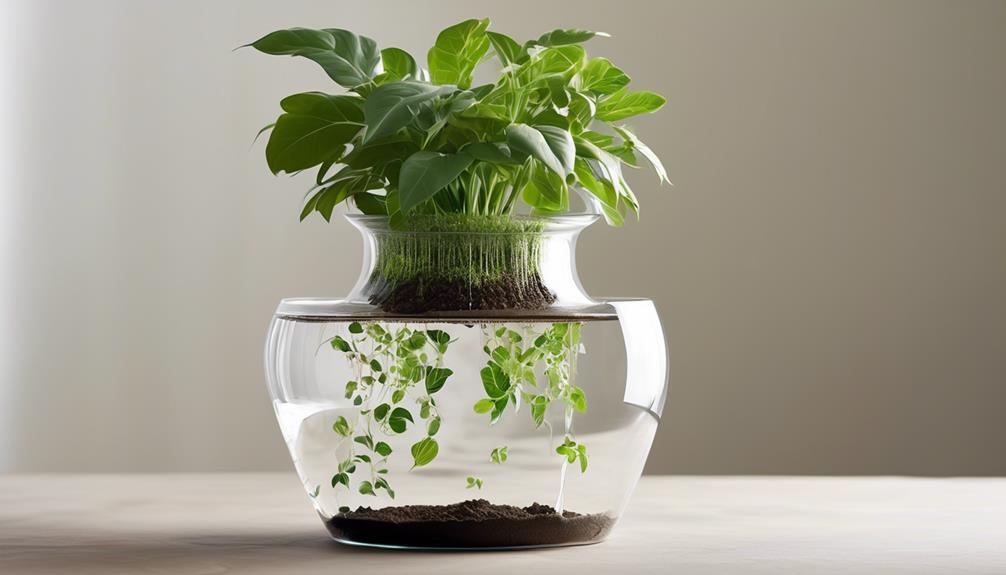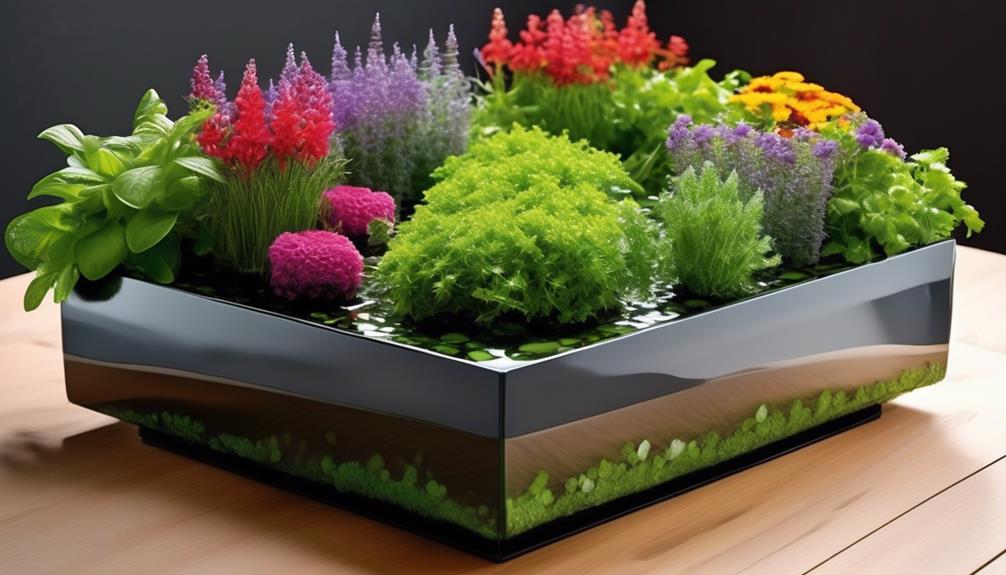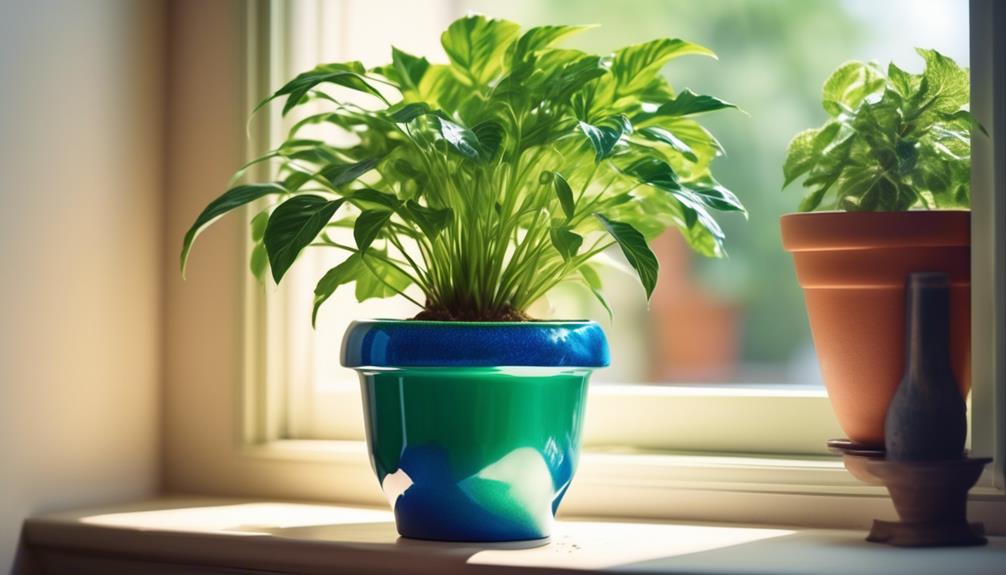African violets are highly regarded as one of the most beloved indoor plants in the United States, with over 20 million plants sold annually.
But have you ever considered planting them in self-watering pots? It's a game-changer for anyone looking to simplify their plant care routine.
But before we get into the nitty-gritty of how to do it, there are a few important factors to consider when selecting the right self-watering pot for your African violets.
Key Takeaways
- Select the right self-watering pot based on size, material, and wicking mechanism
- Use well-draining soil and a balanced fertilizer in the potting mix
- Gently transfer the African Violet to a new pot, untangling the roots and adding fresh potting mix for support
- Monitor soil moisture, adjust humidity levels, and maintain the overall health of the African Violet
Selecting the Right Self-Watering Pot
When selecting the right self-watering pot for African violets, it's crucial to consider the size, material, and wicking mechanism to ensure optimal growing conditions.
Choosing the right material is essential for the health of African violets. Porous materials like terracotta can wick moisture away from the soil, while plastic pots can retain too much moisture, leading to root rot. Therefore, it's advisable to opt for pots made of glazed ceramic or high-quality plastic to strike a balance between moisture retention and breathability.
Additionally, size considerations are paramount. A pot that's too large can lead to overwatering, while a pot that's too small can cause the soil to dry out quickly. For African violets, a pot that's 4-6 inches in diameter is generally suitable for accommodating their root systems without excess moisture.
Preparing the Potting Mix
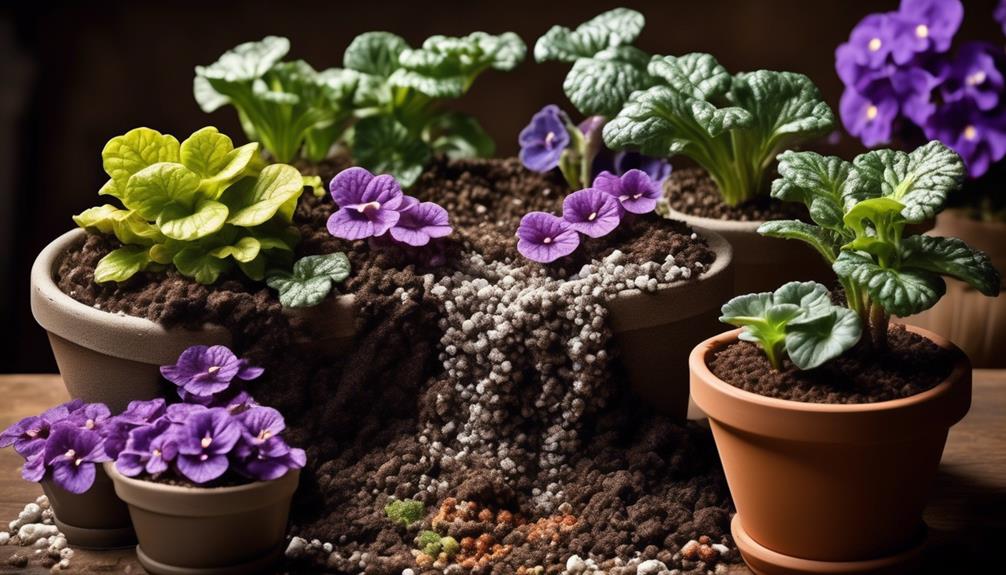
Selecting the right self-watering pot for African violets plays a crucial role in their health and growth. Now, we'll focus on the essential step of preparing the potting mix.
Properly mixing soil for African violets is crucial for their overall well-being. To prepare the potting mix, consider the following:
- Use well-draining soil: African violets thrive in well-draining soil to prevent waterlogging, which can lead to root rot. A mix specifically formulated for African violets or a blend of peat moss, vermiculite, and perlite is ideal.
- Incorporate a balanced fertilizer: When preparing the potting mix, consider adding a balanced fertilizer to provide essential nutrients for the African violets. A 20-20-20 fertilizer is suitable for promoting healthy growth and blooming.
- Establish a fertilizing schedule: Develop a fertilizing schedule to ensure the African violets receive the necessary nutrients. Typically, fertilize the plants every 2-4 weeks during their active growing season, and reduce this frequency during the dormant period.
Transferring the African Violet
Have you prepared the potting mix and selected the right self-watering pot? Now we'll carefully transfer the African Violet into its new container.
The transplanting process is crucial for the proper care and continued health of your African Violet. First, gently remove the plant from its current pot by holding the base of the plant and tipping the pot to slide out the root ball. If the plant resists, you can tap the pot's edge to loosen it. Inspect the roots and carefully untangle any that are tightly wound or circling the root ball.
Next, place a layer of fresh potting mix in the bottom of the new self-watering pot. Position the African Violet in the center, ensuring that the top of the root ball sits about an inch below the rim of the pot. Add more potting mix around the sides, gently pressing it down to provide support.
Water the plant thoroughly and place it in a location with indirect sunlight. Lastly, be sure to monitor the soil moisture and adjust the self-watering mechanism as needed to maintain optimal growing conditions.
Watering and Maintenance
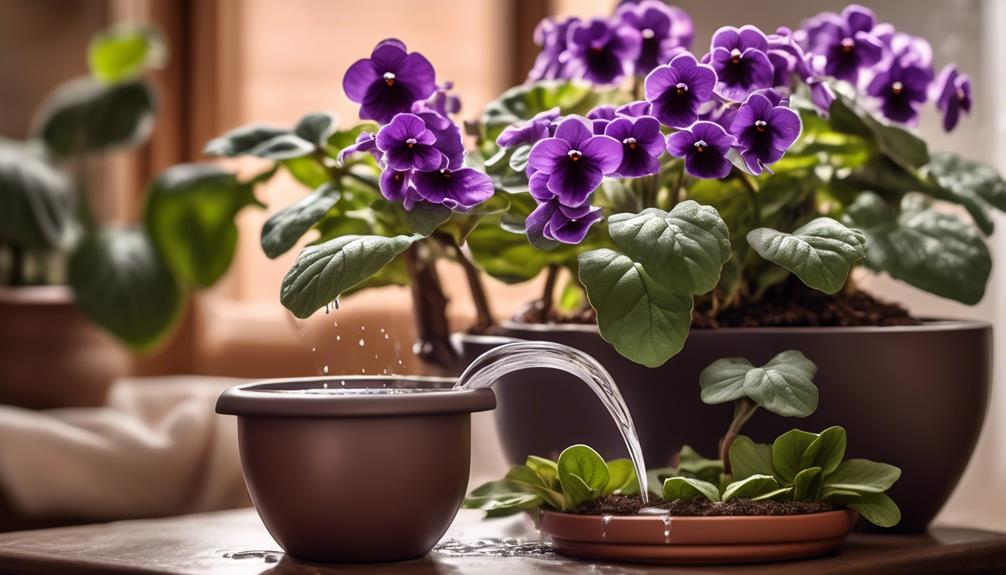
To ensure proper watering and maintenance of your African Violet in a self-watering pot, it's essential to monitor the soil moisture regularly and adjust the self-watering mechanism as needed to maintain optimal growing conditions. Proper watering is crucial for the health of African Violets. Here are some tips to help you maintain the ideal environment for your plant:
- Monitor Soil Moisture: Check the soil moisture regularly by inserting your finger about an inch into the soil. If it feels dry, it's time to add water to the self-watering pot.
- Adjusting Humidity: African Violets thrive in environments with high humidity. If the surrounding air is too dry, consider using a humidity tray or room humidifier to maintain the moisture levels around the plant.
- Cleaning and Maintenance: Regularly clean the self-watering pot to prevent the buildup of algae, mineral deposits, or mold. This ensures that the water supply remains clean and free from contaminants, promoting the overall health of your African Violet.
Troubleshooting Common Issues
When troubleshooting common issues with African Violets in self-watering pots, our focus turns to identifying and resolving any factors that may affect the plant's water intake and overall health. Two common problems that may arise are pest control and soil acidity.
| Problem | Solution |
|---|---|
| Pest Infestation | Use insecticidal soap to control pests such as aphids and mites. Regularly inspect the plant and isolate any infested ones to prevent the spread. |
| Soil Acidity | Test the soil pH using a simple kit available at gardening stores. Adjust the acidity by adding small amounts of lime to raise the pH or sulfur to lower it. Keep the pH level around 6.5 for optimal growth. |
Pest control is crucial in maintaining the health of African Violets. Insecticidal soaps are effective in controlling common pests like aphids and spider mites. Regularly inspecting the plants for any signs of infestation and isolating affected ones can prevent the spread of pests. Additionally, testing the soil acidity is important as African Violets thrive best in slightly acidic soil with a pH level around 6.5. Adjusting the soil pH using appropriate materials like lime or sulfur can help maintain an optimal growing environment for the plants.
Frequently Asked Questions
Can African Violets Be Grown in Regular Pots Instead of Self-Watering Pots?
Yes, African violets can be grown in regular pots, but there are benefits to using self-watering pots.
When growing African violets in regular pots, it's important to monitor moisture levels closely and water them regularly.
Self-watering pots provide a more consistent moisture level, which can be beneficial for African violets.
The self-watering feature can help prevent over or under watering, leading to healthier and more vibrant plants.
How Often Do I Need to Clean the Self-Watering Pot to Prevent Mold and Algae Growth?
We find that cleaning the self-watering pot every 2 weeks is effective in preventing mold and algae growth.
We use a mixture of 1 part vinegar to 3 parts water to scrub the pot, ensuring all surfaces are thoroughly cleaned.
Additionally, we make sure to rinse the pot with clean water before refilling it with fresh water.
This routine helps maintain a healthy environment for the African violets while minimizing mold and algae issues.
Can I Use Tap Water in the Self-Watering Pot, or Do I Need to Use Distilled Water?
We typically opt for tap water in our self-watering pots, but distilled water has benefits for African violets. It's crucial to avoid overwatering, so we monitor the watering frequency.
Maintaining proper temperature and humidity is essential for these delicate plants. When using self-watering pots, preventing root rot is a priority, so we ensure the pots have good drainage.
Cleaning the pots regularly helps prevent mold and algae growth, maintaining a healthy environment for our African violets.
Are There Any Specific Temperature or Humidity Requirements for African Violets in Self-Watering Pots?
In maintaining African violets in self-watering pots, it's crucial to pay attention to temperature requirements and humidity levels. These plants thrive in temperatures between 65-75°F (18-24°C) during the day and slightly cooler at night.
Additionally, they prefer a humidity level of 40-60%. To create the ideal environment, consider using a humidity tray or room humidifier.
Monitoring these factors will contribute to the overall health and vibrancy of your African violets.
How Do I Prevent Overwatering or Root Rot in Self-Watering Pots for African Violets?
To prevent overwatering and root rot in self-watering pots for African violets, we recommend using a well-draining potting mix specifically designed for these plants.
It's crucial to monitor the soil moisture levels and only water when the top inch of the soil feels dry to the touch.
Additionally, ensure the pots have proper drainage to prevent water accumulation.
This approach helps maintain the ideal moisture levels and prevents root rot.
Is It Safe and Effective to Plant African Violets in Self-Watering Pots?
Yes, planting African violets in self-watering pots can be safe and effective as long as the pots are properly designed for the specific needs of the plants. The self-watering feature can help maintain consistent moisture levels, but it’s important to monitor the soil and adjust watering as needed.
Conclusion
In conclusion, planting African violets in self-watering pots is a great way to ensure they receive the right amount of water and thrive.
Remember, a watched pot never boils, so be patient as you wait for your violets to grow and bloom.
With the right pot, potting mix, and care, your African violets will bring beauty and color to your home for years to come.
Happy planting!

